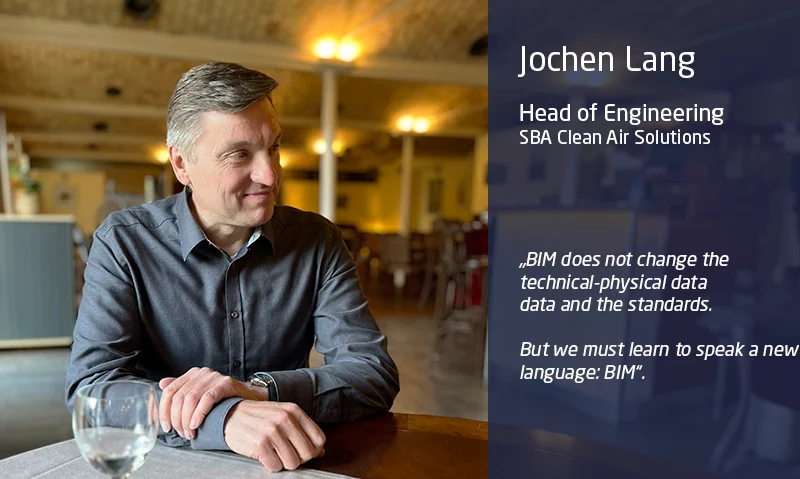At 12 noon, Jochen Lang arrives with a friendly smile, coming directly from a client meeting. . He sits down and orders Frankfurt-style carbonara with bacon, seven herbs, arugula, and parmesan During the interview, Jochen Lang speaks thoughtfully and professionally—qualities for which he is well-regarded.
Mr. Lang, what does the introduction of Building Information Modeling mean for air conditioning technology?
In the initial phase, it entails a great deal of work for everyone involved. The transition is comprehensive, comparable to moving from paper-based planning to CAD. In the next phase, BIM will make planning and execution simpler, faster, and more efficient. For our clients, the benefits are significant: access to up-to-date, transparent data at all times.
How far along is Weiss Technik in implementing BIM?
We're right in the middle of it, working on two major BIM projects for Siemens and the Fraunhofer Institute. These projects also allow us to see where there is room for improvement. This includes the creation and maintenance of data sets, as well as software training for employees, conversion of established processes, and much more. To save time and money with BIM, significant upfront investment is required.
What are the prospects for BIM in air conditioning technology?
BIM is inevitable and will become standard—it’s only a matter of time. Clients are increasingly asking for BIM. In three to five years, firms without BIM capabilities will be excluded from certain projects. Currently, large projects are the primary drivers, but smaller projects will soon follow as the benefits of BIM - despite the additional effort - become apparent.
What are the advantages of BIM planning?
The fact is that all construction projects take place within the magic triangle of costs, quality and time. Each trade and each company has found its own way to make more or less reliable projections. BIM is a tool that makes it possible to make much more reliable projections, much faster. This is good for everyone, because it creates transparency - not only on the construction site, but in all other areas as well.
Can you elaborate?
BIM greatly simplifies coordination between trades. In the past, each trade planned its work separately and hoped that everything would come together. Often, it was not until we got to the construction site that we saw where there were going to be problems because a joint didn't fit, a pipe was in the way, or something else was causing a problem. Then there were discussions and the question of who was to blame and who would bear the costs. Not to mention the implications for the schedule. In an ideal BIM environment, such problems are resolved digitally before construction begins.
What defines an ideal BIM environment?
BIM isn’t new; it has been used successfully in infrastructure projects for years. Nevertheless, coordination problems still exist. Now, BIM is also being introduced in other industries, such as air conditioning technology. This means that the entire industry will have to reorganize and restructure. Needless to say, not everything is immediately clear and unambiguous. So we are currently using two approaches and realizing projects based on either classic CAD or BIM, depending on the customer and project. This is a little more time-consuming, but it provides the necessary certainty for the time being. As soon as everything is in place, we'll change that.
What has been your experience with BIM projects?
We are currently using BIM in the design of a highly specialized dry room for the manufacture of lithium-ion batteries for electric vehicles. The process has gone smoothly, thanks in part to the involvement of a BIM coordinator who oversees BIM-compliant design and construction - a great benefit to all involved.
What is the key to successfully introducing BIM?
Data is paramount. Which is why it is important to start by gathering data and feeding it into the system in the right place and in the required format. Communication concerning BIM is just as important, especially at the beginning. This is because the various trades have to coordinate with each other. One example is the depth of data required: are dimensions and performance data sufficient, or does every screw down to the last thread need to be included? A BIM coordinator is invaluable in facilitating such discussions.
How do you see BIM evolving?
It is clear to me that BIM will become the new standard for projects above a certain size relatively quickly. However, this will be accompanied by an increasing number of smaller projects, especially more complex construction projects. Laboratories, for example, will benefit because BIM enables high-quality and detailed visualizations at an early stage. Marketing will also benefit from these opportunities.
Do BIM and AI necessarily go hand in hand?
Yes and no. Artificial intelligence, or AI, is currently a hot topic. Of course, AI will also play a role for BIM. As things stand today, I see it primarily as a tool for providing support, taking on subtasks and facilitating routine work. Exactly what these are and how they can be integrated into the overall planning will become clear in the next few years.
Thank you for the interview, Mr. Lang, and bon appétit.
Some Facts About Graduate Engineer Jochen Lang
Jochen Lang, a graduate in mechanical engineering and business administration, has been head of engineering at Weiss Klimatechnik for nine years. In his free time, he enjoys exploring nature by bike or on foot. When it comes to food, he appreciates regional cuisine, which he always tries to include in his many business trips.
BIM – Building Information Modeling
BIM is the networked planning, construction and management of buildings based on standardized software and a shared digital database.
This allows all parties involved in the construction process to access current and detailed data at any time. Depending on the project, the data can include a range of information on the construction, materials and progress, as well as on costs and scheduling. The data exchange is standardized and available throughout the entire life cycle of the building.


